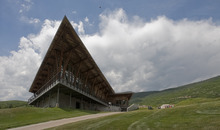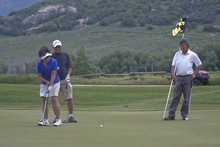This is an archived article that was published on sltrib.com in 2011, and information in the article may be outdated. It is provided only for personal research purposes and may not be reprinted.
Utah's public golf courses are struggling to make ends meet. A combination of too many courses, too few players and one of the wettest springs in recent memory have managers scrambling for money and looking for ways to cut costs.
This is especially true for Utah State Park's four courses, the 36-hole Wasatch Mountain, 36-hole Soldier Hollow, 18-hole Palisade and 9-hole Green River layouts. A January report to the Utah Legislature by its auditors shows that of the four, only Wasatch Mountain is making money. The other three require subsidies.
The audit left some lawmakers wondering if the state should even be in the golf business, or if courses would be better operated by private interests, city or county recreation departments.
"I believe that golf courses that can be better managed privately or locally and are money losers to the state should be transferred," said Sen. Lyle Hillyard, a member of the Legislature's powerful executive appropriations committee.
That might be a trickier task than meets the eye.
Portions of the parks where all four state-owned courses sit were purchased with federal Land and Water Conservation Funds, which means those lands cannot be used for anything but public recreation — unless the federal government is reimbursed for its investment. That doesn't mean that courses can't be closed and the land left as open space, an act that would require the state to walk away from huge investments in development and equipment.
State Parks director Mary Tullius said her agency has created enterprise funds for its golf courses similar to courses in Salt Lake and Davis counties. If a course earns $1 million, its budget is $1 million. That's for operations alone. Replacing old equipment or making improvements in facilities might require a different model.
"I felt that with all the criticism Green River and Palisade courses were getting that perhaps our only hope of saving golf and keeping it from being privatized was to operate as an enterprise fund," she said. "Now this is easier said than done. There are significant gaps for both Green River and Palisade. We worked out a dozen or so scenarios and settled on a three- to five-year plan."
Each course was given a budget that is below what it has had in the past as part of a first phase to reach a balanced budget. The agency hopes expenses will be met through a combination of cuts, increased play and resulting revenue, and local counties or cities helping with subsidies.
No general tax dollars will be spent. Losses will be subsidized with park fees.
Should taxpayers subsidize golf at any level of government? Or should users pay all the costs?
"Public golf is no different than a public park or public recreation of any sort," said Dave Terry, director of golf for Salt Lake City. "It is an amenity for the public that they desire and there is a demand for. It doesn't get provided without the public stepping in. Utah is unique in the percentage of golf courses that are publicly owned. That is something citizens ought to be proud of along with current government officials."
One problem is the glut of new public and private courses that are competing with the state parks. In the area near Wasatch Mountain and Soldier Hollow alone, five new private layouts have opened in recent years. From 1990 to 2007 in the area from Provo to Ogden and Tooele to Midway, the number of public golf holes increased by 95 percent.
"That makes it a challenge for everybody," said Terry. "It requires operators to provide discounts along with already low green fees."
Of course, for golfers, it means Utah is a wonderful place.
Bob Zusman of Granite Creek, Calif., played 18 holes at Wasatch Mountain and nine at Soldier Hollow recently. He said the $42 for a cart and 18 holes in Utah compares with $65 in California and rounds at private facilities that can go into the hundreds of dollars.
Wasatch Mountain manager Bruce Strom says that budget cuts mean maintaining courses at a level to lure Salt Lake and Utah county golfers to Midway is becoming increasingly difficult. Shaggy greens, longer grass in the roughs and less manicured courses at the state parks may cause players to choose a public course closer to home.
Another issue is that midday corporate tournaments that can bring in as much as $10,000 on an otherwise slow summer weekday to Wasatch Mountain State Park require staff to promote and maintain. Strom said the position for the assistant pro who was group tournament coordinator had to be cut. A private contractor may do some marketing.
Legislators have also told Strom to merge maintenance operations at Soldier Hollow and Wasatch Mountain, something he said is impractical because equipment is already nearly maxed out at both places.
Soldier Hollow — a more difficult open links-style course than Wasatch that can be hot and windy — has not met projections for rounds played in the seven years it has been open, making it difficult to pay off the revenue bond that was floated to pay for its construction. Wasatch Mountain is also paying off a revenue bond used to add nine holes and rebuild the clubhouse. Wasatch Mountain turns a $600,00 to $800,000 profit most years, but the bond payment eats up some of that. The bond payment guarantees a substantial loss at Soldier Hollow.
Glen Van Wagoner, the concessionaire at the clubhouses of the two Wasatch courses that employ 52 during the summer months, has been working at the courses since he was 13. He wishes the state would have paid off those two revenue bonds in the early part of the century when it was running budget surpluses.
"Sometimes there are things in life that only government can provide," he said.
The question in these tight budget times, though, is if state government wants to continue to provide enough money to operate its golf courses.
Twitter @tribtomwharton —
State Park golf courses profit/loss
Based on fully allocated costs for fiscal 2010
Source: Office of the Utah Legislative Auditor General* not counting a revenue bond payment; ** not including administrative costs







